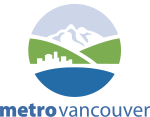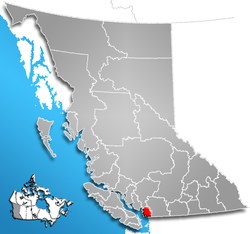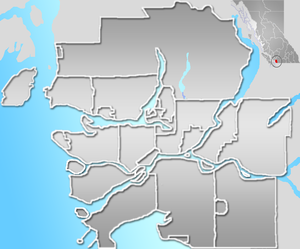- Metro Vancouver
-
This article is about the governing body of the Greater Vancouver Regional District. For the urban geographic entity, see Greater Vancouver.
Metro Vancouver — Regional District — Greater Vancouver Regional District A view from Arbutus Ridge, Vancouver 
LogoMotto: Creating A Sustainable Region Location of Metro Vancouver in British Columbia, Canada Coordinates: 49°14′58″N 122°58′47″W / 49.24944°N 122.97972°WCoordinates: 49°14′58″N 122°58′47″W / 49.24944°N 122.97972°W Country  Canada
CanadaProvince  British Columbia
British ColumbiaRegional district Location of head office Burnaby Established 1967 Government[1] – Board Metro Vancouver Board of Directors – Chair Lois Jackson Area[2] – Total 2,877.36 km2 (1,111 sq mi) Elevation 60 m (197 ft) Population (2006)[2] – Total 2,116,581 – Density 735.6/km2 (1,905.2/sq mi) Canadian CD rank: 2nd Time zone PST (UTC-8) Website Metro Vancouver
Municipalities of Metro Vancouver Metro Vancouver is the brand name[3] of the board of the inter-municipal administrative body known as the Greater Vancouver Regional District (GVRD), a regional district in British Columbia, Canada. "Greater Vancouver Regional District" is the official name of the regional district and remains in common use.
The Metro Vancouver board governs the affairs of the Greater Vancouver Regional District, which is charged with certain aspects of governance for the metropolitan area surrounding and including the city of Vancouver, British Columbia, Canada. The Greater Vancouver Regional District was incorporated on June 29, 1967. Greater Vancouver as a region and name emerged when the newly born City of Vancouver expanded to become larger than the older New Westminster. The territory under Metro Vancouver's authority is essentially synonymous with what is usually meant by the colloquial term "Greater Vancouver", although wilderness and outlying rural regions within the regional district are not generally meant when the term "Greater Vancouver" is used. Statistics Canada defines the Vancouver CMA (Census Metropolitan Area) as having perfectly coterminal boundaries with the Greater Vancouver Regional District. Although the region's principal city is Vancouver, its administrative offices are located in the City of Burnaby.
Despite the typical equation of the regional district with the metropolitan area and the geographical region, the many Indian Reserves in the Greater Vancouver region as well as the University Endowment Lands (UEL) are not part of the representation in the regional district (the UEL is in GVRD Electoral Area 'A', but has its own system of government and is outside the regional district's authority). Other political geographic regions parallel to the regional district are the Lower Mainland region of the Ministry of Environment, the Chilliwack Forest District, the New Westminster Land District, and the Fraser Health Authority. Schools are not subject to municipal or regional district governance and are administered via the school districts system.
The Greater Vancouver Regional District was established in 1967,[4] following the creation of Greater Vancouver Sewerage and Drainage District (GVSDD) in 1914 and Greater Vancouver Water District (GVWD) in 1926. In 2007, the GVRD board unanimously supported a proposal to the provincial government to change its official name to Metro Vancouver.[5] While the new name took effect in September 2007, the Province declined to amend the Greater Vancouver Regional District's letters patent to change the name to "Metro Vancouver".[6] The name of the physical area governed by the organization remains the Greater Vancouver Regional District.
Contents
Municipalities
Thirteen of the province's thirty most populous municipalities are located in Metro Vancouver.[7] The official land area of the district is 2,877.36 square kilometres (1,111 sq mi). It is the most densely populated regional district in British Columbia.
The Regional District comprises the governments of 21 incorporated municipalities and one unincorporated area. The 21 municipalities are:
Municipality Type Population Year Anmore village 1,992 2007 Belcarra village 701 2007 Bowen Island island municipality 3,551 2007 Burnaby city 216,336 2007 Coquitlam city 120,512 2007 Delta district municipality 101,668 2007 Langley city 25,134 2007 Langley district municipality 100,049 2007 Lions Bay village 1,394 2007 Maple Ridge district municipality 73,248 2007 New Westminster city 62,607 2007 North Vancouver city 47,463 2007 North Vancouver district municipality 86,954 2007 Pitt Meadows city 16,757 2007 Port Coquitlam city 55,735 2007 Port Moody city 30,004 2007 Richmond city 186,628 2007 Surrey city 394,976 2007 Vancouver city 578,041 2007 West Vancouver district municipality 44,097 2007 White Rock city 19,839 2007 Electoral Area A unincorporated area 19,252 2007 Greater Vancouver Regional District regional district 2,249,725 2007 Abbotsford is a member for parks purposes only.
Greater Vancouver Regional District Electoral Area A comprises all unincorporated land within the Regional District boundaries, and includes the University of British Columbia, the University Endowment Lands, and residential areas and isolated dwellings on Howe Sound between Lions Bay and Horseshoe Bay, on Indian Arm to the north of Deep Cove and Belcarra/Anmore, and on the west side of Pitt Lake to the north of Port Coquitlam. Passage Island and Barnston Island in the Fraser River and are classified as Regional District Remainders.[8]
There are also seventeen Indian reserves within the geographical area that are not subject to governance by the municipalities or the Regional District; they have a combined population of 7,550 (2006).
The cities of Abbotsford and Chilliwack and the district of Mission, located to the east, although often linked to Vancouver in promotions and tourism, are part of a separate regional district, the Fraser Valley Regional District, though part of the same region, the Lower Mainland. See Greater Vancouver for the larger geographic region meant by that term ("Metro Vancouver" refers only to the government of the regional district, and the regional district is not exactly coterminous with the region as such).
Administrative role
The principal function of Metro Vancouver is to administer resources and services which are common across the metropolitan area. These include community planning, water, sewage, drainage, housing, transportation, air quality, and parks.
There are three legal entities that operate under the name Metro Vancouver: the Greater Vancouver Water District (GVWD); the Greater Vancouver Sewerage and Drainage District (GVS&DD); and the Greater Vancouver Regional District (GVRD). The Metro Vancouver Housing Corporation is wholly owned by the Greater Vancouver Regional District.
Greater Vancouver Regional Parks oversees the development and maintenance of nineteen regional parks, as well as various nature reserves and greenways. (The regional parks are distinct from municipal parks in that they are typically more "wild" and represent unique geographical zones within the region, such as bogs and mature rainforests.)
Although the Greater Vancouver Water District comprises a system that covers more than 2,600 km², all the water for the district comes from three sources: the Capilano reservoir, the Seymour reservoir, and the Coquitlam reservoir. Metro Vancouver controls the Cleveland Dam on the Capilano reservoir, which supplies 40 percent of the district's water.[9]
One initiative of the Greater Vancouver Sewerage and Drainage District was the Ashcroft Manor Ranch Mega-Landfill Proposal in Ashcroft, British Columbia, in the Thompson Country of the British Columbia Interior, as there is no more room in the Lower Mainland for Metro Vancouver's garbage. A similar project nearby adjacent to the town of Cache Creek, British Columbia has almost reached capacity. Environmental concerns about the area's sensitive shrub-steppe climate and ecology are strong, while Highland Valley Copper, near Logan Lake, has offered the use of its mine-pit instead. Other GVSDD landfill locations serving the regional district in the past have been in the Fraser Mills area, between the Trans-Canada Highway and the Fraser, and at Port Mann, beneath the south foot of the [[Port Mann Bridge.
Demographics
According to the 2001 census, 1,986,965 people lived in the metropolitan area, about half of the population of British Columbia. The 2006 census reported the population at 2,116,581, a 6.5 percent increase since the last census.[10]
In 2006, Metro Vancouver had a population of 2,116,581 living in 870,992 dwellings. The regional district has a land area of 2,877.36 km2 (1,110.95 sq mi) and a population density of 735.6 /km2 (1,905 /sq mi).[2]
Metro Vancouver has a large ethnic minority population. The 2006 census showed that nearly 41.7% of the population were of visible minority origin, the largest visible minority group being Chinese, followed by South Asians. Other prominent groups include Filipinos, Koreans, Japanese, Southeast Asian, West Asian, and Latin Americans.[11] British Columbia is Canada's most ethnically diverse province.[12]
See also
- Greater Vancouver
- Greater Victoria, British Columbia
Notes
- ^ Metro Vancouver. "Boards and committees". http://www.gvrd.bc.ca/board/membership.asp. Retrieved July 4, 2007.
- ^ a b c Statistics Canada (Census 2006). "Greater Vancouver Regional District – Community Profile". http://www12.statcan.ca/english/census06/data/profiles/community/Details/Page.cfm?Lang=E&Geo1=CD&Code1=5915&Geo2=PR&Code2=59&Data=Count&SearchText=Greater%20Vancouver&SearchType=Begins&SearchPR=01&B1=All&GeoLevel=&GeoCode=5915. Retrieved July 4, 2007.
- ^ http://www.canada.com/vancouversun/news/story.html?id=47d814e0-3cf9-4577-bc14-d6b8518fc30b&k=15838
- ^ Western Economic Diversification Canada. "The Greater Vancouver Regional District (GVRD)". http://www.wd.gc.ca/eng/10654.asp. Retrieved April 3, 2009.[dead link]
- ^ Skeleton, Chad (August 3, 2007). "Goodbye GVRD, hello Metro Vancouver". Vancouver Sun (Canada). http://www.canada.com/vancouversun/news/story.html?id=47d814e0-3cf9-4577-bc14-d6b8518fc30b&k=15838. Retrieved August 3, 2007.
- ^ http://communities.canada.com/vancouversun/blogs/papertrail/archive/2008/07/23/why-the-province-said-no-to-metro-vancouver-s-name-change.aspx
- ^ Statistics Canada – BC municipalities – Population
- ^ Greater Vancouver – BC Stats 2007 Population Estimates
- ^ Metro Vancouver Water Sources & Supply
- ^ Greater Vancouver Regional District – Population Growth
- ^ [1], canada.com, April 2, 2008.
- ^ [2], cbc.com, April 2, 2008.
External links
Municipalities of Metro Vancouver Population over 100,000 Population over 50,000 Population over 10,000 Population under 10,000 Unincorporated areas  Subdivisions of British Columbia
Subdivisions of British ColumbiaSubdivisions Regions · Regional districts · Forest Regions and Forest Districts · School districts · Land DistrictsSettlements Urban centres Regional districts Alberni-Clayoquot · Bulkley-Nechako · Capital · Cariboo · Central Coast · Central Kootenay · Central Okanagan · Columbia-Shuswap · Comox Valley · Cowichan Valley · East Kootenay · Fraser Valley · Fraser-Fort George · Kitimat-Stikine · Kootenay Boundary · Greater Vancouver · Mount Waddington · Nanaimo · North Okanagan · Northern Rockies · Okanagan-Similkameen · Peace River · Powell River · Stikine Region (non-RD) · Skeena-Queen Charlotte · Squamish-Lillooet · Strathcona · Sunshine Coast · Thompson-NicolaCensus metropolitan areas (CMAs) in Canada by size Toronto, ON · Montreal, QC · Vancouver, BC · Ottawa, ON · Calgary, AB · Edmonton, AB · Quebec City, QC · Winnipeg, MB · Hamilton, ON · London, ON · Cambridge-Kitchener-Waterloo, ON · St. Catharines-Niagara, ON · Halifax, NS · Oshawa, ON · Victoria, BC · Windsor, ON · Saskatoon, SK · Regina, SK · Sherbrooke, QC · St. John's, NL · Barrie, ON · Kelowna, BC · Abbotsford, BC · Greater Sudbury, ON · Kingston, ON · Saguenay, QC · Trois-Rivières, QC · Guelph, ON · Moncton, NB · Brantford, ON · Thunder Bay, ON · Saint John, NB · Peterborough, ON
Categories:- Metropolitan areas of Canada
- Regional districts of the British Columbia Coast
- Greater Vancouver Regional District
- Politics of Vancouver
- Geography of Vancouver
- Metropolitan planning organizations
Wikimedia Foundation. 2010.




